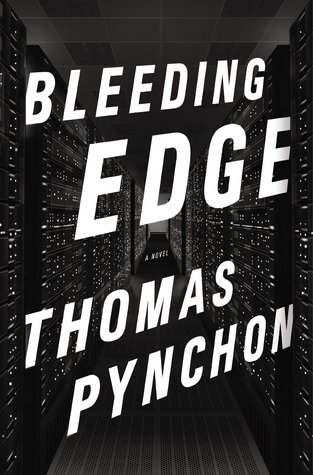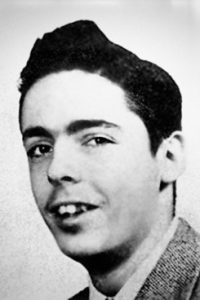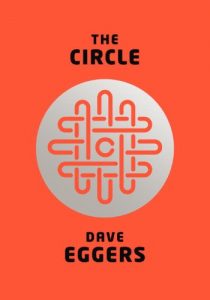Essay by Dan Geddes
See also:
The Crying of Lot 49,
Gravity’s Rainbow,
Vineland,
Inherent Vice, and
Dys, an imaginary Pynchon novel
Most Thomas Pynchon fans will not be disappointed by Bleeding Edge, his new novel set in New York in 2001. Some may be disappointed that it’s not Gravity’s Rainbow, but it’s very funny and more accessible than most of his works. He’s still using the breezy writing style from Inherent Vice, but this doesn’t make it “Pynchon Lite” (as Michiko Kakutani asserts). Bleeding Edge is clear, which is not always true of his early classics. It has the heft and density of many Pynchon works, and it’s arguably funnier.
Bleeding Edge is also more obviously topical than earlier works. The novel focuses on the growing role of the Internet in our lives, and also on the 9/11 attacks. Bleeding Edge is bursting with insights into U.S. society—and New York in particular—just before and after the destruction on September 11, 2001; the contrast is marked.
2001 was the year zero of the 21st century, the starting point for the never-ending U.S. Global War on Terror, which has defined the century so far. Bleeding Edge covers the period just before and after 9/11/2001 (“11 September” Pynchon calls it, using European time formats, perhaps trying to break the spell of “9/11”), a key turning point in modern history.
Bleeding Edge fills in the most recent gap in the historical timelines covered by his novels. Parts of Vineland take place in the late 1980s, but his fiction doesn’t cover any period more recent than that—until now.
Bleeding Edge has something for everyone: a strong, outspoken, hilarious, effective, sexy, Jewish mother/investigator/narrator in Maxine Tarnow; a sinister, if shadowy, villain of our time in Gabriel Ice; a great setting: New York between the dot-com bubble and the aftermath of the 9/11 attacks. One of the joys of reading Pynchon’s works is that he can tackle serious and even depressing themes with a funny and life-affirming tone. Bleeding Edge is more love-song to New York than meditation on the rollback of civil liberties.
Despite the “heavy” themes, Pynchon is clearly enjoying himself, creating his vision of New York circa 2001. Bleeding Edge is full of names and places factual and fictional. The author himself has been living on the “Yupper West Side” for many years and reveals his characteristic expertise about city layout, demographics, and city history.
The main character, Maxine Tarnow, takes us into fascinating bars, restaurants, corporate offices, homes, cars, boats, and so on, throughout New York and its environs. Bleeding Edge is as much about New York as anything else. Pynchon is a knowledgeable tour guide through Manhattan, just as he was for 1970 Los Angeles in Inherent Vice. After peregrinations through the city we read: “‘This is fun,’ sez the Cabbie. ‘Where next?'” And we agree with the Cabbie. It is fun.
Maxine’s characterization is enjoyable throughout. She is a former Certified Fraud Examiner, who was decertified for unknowingly abetting an offense. No matter. She still has a carry permit for her guns, unusual courage and an uncanny intuition for questioning people. She is a private detective in all but name. Other characters instinctively turn to her for help.
Maxine is also the mother of two boys, and is a fun and responsible parent. She is an attractive woman (not beyond pole-dancing on “MILF night” if it helps her investigation), and bears a strong resemblance to actress Rachel Weisz (according to one character).
Pynchon relays Maxine’s well-connected life to us in his usual omniscient style. His credibility comes from his seeming to know so much more about everything than almost everybody. Tolstoy could seem God-like in his great novels; Pynchon can also sound truly omniscient. A key difference is that Pynchon frequently undermines his own authority or possible pretentiousness with his wacky sense of humor.
The humor is used to inject levity, or to present details about various tangential fields of knowledge: pop music, baseball, engine mechanics, UNIX commands, commodity trader jargon, Hollywood movies, and, of course, conspiracy theories (the Montauk Project, 9/11, TWA 800, etc.). These are familiar themes, but now in a chronicle about recent history.
After a while, reading Bleeding Edge starts to feel like watching a highbrow TV series. We are happy spending time with these characters.
***
Bleeding Edge is preoccupied with the Internet as the dominant force in our lives, much like Vineland described the role of TV (“The Tube”). In Inherent Vice, characters were already becoming addicted to the DARPANET, the forerunner of the internet. But here we see the modern Internet, including Deep Archer, a Second Life sort of Internet environment of great importance to the story. Maxine is casual friends with the software’s creators and Gabriel Ice is trying to obtain it. Despite her initial skepticism, she eventually spends countless hours “on” Deep Archer. Pynchon gives it spiritual importance with suggestions that the dead can somehow still exist through the medium of the Internet. These are the half-dead, sort of like the Thanatoids in Vineland, but here as Internet avatars. There’s a resemblance between people spending their lives staring at screens and the half-living Thanatoids.
While Gabriel Ice is clearly the chief antagonist, he is described from a distance. Maxine only has direct contact with him on a few occasions, even though she is investigating him and his actions affect most of the secondary characters.
Thematically Gabriel Ice serves as stand-in for U.S. security forces’ infiltration of the Internet. Ice is not very developed as a character, but his empire is vast enough to contain several plot threads. His goals are not entirely clear. As one character says, he was “a pioneer dick” of the Silicon Alley dot-com days, so he is respected. We know that when Ice met his wife, Tallis, in college that he was more innocent and probably likeable then, before selling out to the dark side.
Yet Pynchon accomplishes what he set out to do: Bleeding Edge is a ripping tale, with arguably the clearest storyline of any Pynchon work. Chronology is generally followed, with fewer and simpler flashbacks than in other works. The multi-channeled plot revolving around Maxine’s quest to discover the secrets of Gabriel Ice are clear and well-structured. The story is strong much of the way. The supporting characters are compelling, and Maxine makes progress into illuminating the Gabriel Ice mysteries.
On the other hand, Pynchon suggests that mysteries do not wrap up themselves up cleanly. This may not meet all readers’ expectations of fiction, but Pynchon’s endings rarely wrap everything up neatly.
***
Bleeding Edge is fun to read for its wealth of incisive observations about contemporary life, especially in the first half of the book. Placing 9/11 after two-thirds through the book highlights the contrast in pre- and post-9/11 life in New York. Characters even notice the change while watching syndicated “Sitcoms from more optimistic times.”
The story flags a bit in the second half. The action slows down after the events of 9/11. Many of the characters are in a state of shock, and Pynchon flattens his prose during the 9/11 aftermath. Maxine experiences the 9/11 attacks mainly in a “mediated” way through the TV and hearsay reports, so she feels the shock second-hand. Even in New York: “A viewing population brought back to its default state, dumbstruck, undefended, scared shitless.”
Sympathetic characters such as March, Maxine’s friend, and Ernie, her father, toy with 9/11 conspiracy theories. The narrator himself, despite omniscience on matters within the story, and general suspicions about the government in general, does not claim to know what really happened. He even invents the Stinger missile on the roof incident, which resembles other stories surrounding 9/11.
The characters express different opinions about 9/11, with March openly blogging about U.S. government involvement in 9/11. Brooke, Maxine’s sister, becomes livid when anyone questions the government’s story. Maxine stays objective about it.
Ernie, Maxine’s father, is openly skeptical of the official government story. Ernie has no problem believing in conspiracy theories:
The chief argument against conspiracy theorists is always that it would take too many people in on it, and somebody’s sure to squeal. But look at the U.S. security apparatus, these guys are WASPs, Mormons, Skull and Bones, secretive by nature. Trained, sometimes since birth, never to run off at the mouth. If discipline exists anywhere, it’s among them. So of course it’s possible.
Pynchon creates mouthpieces for a conspiratorial perspective of 9/11, but Pynchon the narrator does not endorse these theories.
***
Despite the trauma of the 9/11 attacks Maxine lives a zesty life. She is the agent of progress in the story, willing to confront anyone in her path, sometimes in a fearless, playful way. (She finds herself acting uncharacteristically submissive, however, to one important supporting character.) Maxine’s life involves so much more than the vast Gabriel Ice conspiracy. She is investigating several mysteries and is involved in the doings of dozens of characters. Pynchon does well managing all the characters and plot-strands.
Not everyone will find Maxine a convincing portrait. After all she does some amazing things: pole-dances, confronts dangerous people, flees the U.S. coast guard in a boat, among many others. The sheer variety of her activities and the number of coincidences will strain credulity. That doesn’t make her a bad character.
It is surprising that she would have the time, energy and resources to continue her investigation into Gabriel Ice when no one is paying her. Why is she still interested in it? Curiosity? On the other hand, it’s an accepted technique of the detective genre that the detective continues even when the rewards of solving the case are not worth the effort or are even non-existent.
Pynchon has often depicted and alluded to extremely unusual events. Many extraordinary things are afoot in this novel. The story might seem incredible to some reviewers. Yet Bleeding Edge is full of extraordinary scenes, even if it uses devices such as coincidence, caricature, and ludicrous events to move the story along.
***
It’s refreshing that Pynchon hasn’t changed his style much. He can be authoritative one moment, and then resort to slapstick humor the next. The recent setting also means that more of his constant pop culture references register. Bleeding Edge is dense of cultural references, enough to fill a small glossary. But contemporary readers will understand so many more of these references than they probably will for Gravity’s Rainbow, Mason & Dixon, Against the Day, or V. Whether it’s about venture capitalists buying “Startups of interest chiefly to the insane” or people eating at places with glorified names like Bagel Quest, Pynchon’s a master social observer.
For many of his readers Pynchon serves as an oracle, as an authority on so many subjects, including, perhaps most importantly: What is “hip” and “cool”? And: What is funny?
Pynchon has a sensitive ear for the hip and the cool, and for social signifiers. Bleeding Edge is animated by social signifiers and the characters’ response to them. (Though he writes that unlike the class signifiers in Britain “In New York all you really have is shoes.”) Many chapters are scenes of dialogue between Maxine and one or more characters; these exchanges are funny, and feature people measuring each other’s social worth and hipness. This is, after all, what so many people do, (and New Yorkers no less than others).
However, it is a distracting that so many of the characters sound so much like Pynchon. The characters voices are often differentiated; but when they show comic attitude, many of them sound alike (and sound like Pynchon with a ready catalog of evidence in their retorts). The dialogue is usually crisp and riveting with rapid-fire exchanges full of wit and comprehensive details. Most of the characters feel like players; they have goals and know how to talk to find out what they want to know (especially Maxine); or get what they want (Nick Windust, Gabriel Ice).
The early books, great as they are, deliberately used caricature instead of characters to the point of disrespect or abuse; Pynchon seemed to revel in the shoddiness of some of these characters and their preposterous names. For some readers, this contempt of characterization was an unforgivable sin and they never forgave it. The names in Bleeding Edge are still ridiculous, but the characterizations are cleaner, despite many of the characters being too clever by half.
***
The recent revelations about the NSA and PRISM make Pynchon’s career-long “paranoia” about the overweening surveillance state seem prescient. In fact, Pynchon’s cynical realism about government power, and his willingness to face up to that power while still poking fun at it, is one of his trademarks. His characters try to enjoy the freedom in the cracks (as in “The Zone”, the temporary anarchy of post-war Germany in Gravity’s Rainbow). Despite his awareness of creeping government power, his books celebrate freedom, love, sex, good food, wine, recreational drugs, and general silliness.
Pynchon is at his funniest describing the vertigo of characters who realize what they are up against in the authoritarian surveillance state. He has long ago transcended any depression about the state of civil liberties; he’s just trying to enjoy life regardless.
In Bleeding Edge, the Deep Web is a temporary Zone of freedom, but it won’t be for long and soon the electronic handcuffs of mobile phones will bind us all (to paraphrase Ernie).
Family becomes one of the last refuges from the surveillance state. Maxine’s family remains the most important part of her life, despite all the other claims on her attention. The 9/11 attacks drew families together, not least Maxine and her sons and ex-husband, Horst. As Joshua Cohen writes in Harper’s:
For Pynchon—the embattled bard of the counterculture, disabused of all allegiance—the last redoubt has become the family, and the last war to be waged is between our virtual identities and the bonds of blood; a war to keep the Virtual from corrupting the Blood, if not forever, then for time enough to let the lil’ Ziggy and Otis Tarnow-Loefflers [Maxine’s sons] of this world live with the merest pretense of freedom (childhood). (Cohen, 105)
The family, perhaps uniquely among social institutions, still offers safe moments of love and freedom.
***
Pynchon’s comic/erudite/paranoid style is the continuing draw for his audience. At times he reads like an intellectual comic, delivering zinger after zinger, both as narrator and through dialogue. When the narrator is not himself delivering one-hilarious liners, Maxine is cutting through everyone’s lies with probing questions.
Bleeding Edge is Pynchon’s funniest novel with one of his best main characters. Does Bleeding Edge dazzle us with the same shock of discovery or dizzying heights of V or Gravity’s Rainbow? Not really. Critics now expect so much from Pynchon that some fail to appreciate what he has offered us here. The readability, the humor, and the strong characterizations make Bleeding Edge one of his most enjoyable and relevant works.
Dan Geddes
18 September 2013
Amsterdam
Sources
Cohen, J. (2013, October). First Family, Second Life: Thomas Pynchon goes online. Harper’s, pp. 99-105.
Kakutani, M. (2013, September 10). A Calamity Tailor-Made for Internet Conspiracy Theories. Retrieved from New York Times:
Pynchon, T. (2013). Bleeding Edge. London: Jonathan Cape.









Be First to Comment